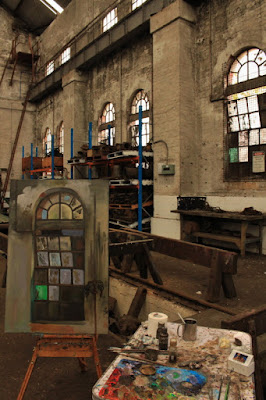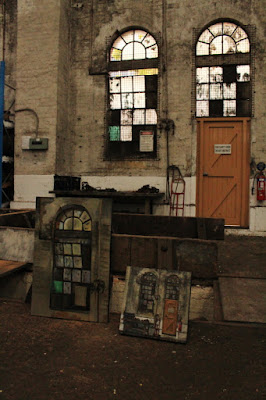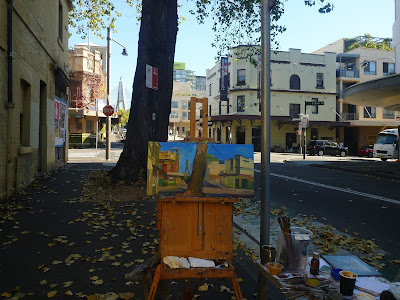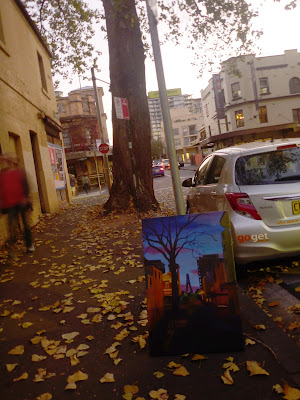
Work in progress - 'Engine shop,
Large Erecting Shop, Eveleigh Railway Workshops'
2017 oil on canvas 46 x 46cm
There has been a lot of uncertainty about the future of the 3801 Ltd, and even of the Large Erecting Shop itself. Many of the relics will probably be lost or put into storage if the site is to become a running shed. This would mean that trains would still run from the shed, but no repair or maintenance work could be carried out. Anything not required merely to run the trains would then be removed from the interior and either sent to Thirlmere, put in storage or even put in a skip bin.
Already a lot of items have been put in the skip or just disappeared.

Work in progress - 'Engine shop,
Large Erecting Shop, Eveleigh Railway Workshops'
2017 oil on canvas 46 x 46cm
This old office in the Large Erecting shop of Eveleigh Railway Workshops, had been used to store stacks of windows and doors waiting to be repaired to refurbish a carriage.
In front of it are lathes, drills and boxes of rusting tools that obviously are many decades old.

Work in progress - 'Engine shop,
Large Erecting Shop, Eveleigh Railway Workshops'
2017 oil on canvas 46 x 46cm
This old office is an example of the sort of item that may not be kept, despite its historical interest.
Before it was used to store windows, it had been the headquarters of the 51⁄2 year restoration of 3830, which was carried out by a team of about 12 volunteers from the Powerhouse Museum and 3801 Limited.
There are still ghost signs that haven't been erased from when the restoration of 3830 started in 1992.

Work in progress - 'Engine shop,
Large Erecting Shop, Eveleigh Railway Workshops'
2017 oil on canvas 46 x 46cm
Enquiries
On the weathered sky blue boards are inscriptions in white chalk about its time of service.
"3830 18 years 11 months 4 days
Into service 27/9/49
Withdrawn 31/10/67 (Illegible) birthday 23 years
Cost £53,145/2/0 Basic Wage 4/8 11/20d/hour
Builders' No 170 40 hours £8/12/0 approx"

Work in progress - 'Engine shop,
Large Erecting Shop,
Eveleigh Railway Workshops'
2017 oil on canvas 46 x 46cm
The blackboard on the left hand side of the window of the old office has a mysterious list of the 38 class locos, split into 2 sections.
The left hand side of the blackboard starts with 3826, 3830, 3802, 3801, 3810, 3812, 3825, 3804, 3813, 3826, 3823, 3818, 3808, 3807, then there is a vertical line.
On the other side 3806 has been almost erased, then 3814, 3811, 3819, 3828, 3806, 3809, 3811, then a few illegible words with "38's are great mate" written over them.

'Engine shop, Large Erecting Shop,
Eveleigh Railway Workshops'
2017 oil on canvas 46 x 46cm
I had wondered why the numbers had been written in such a haphazard order, and why some were missing and others repeated.
It was obviously not chronological, but there was obviously a reason behind it.
The secret was finally revealed by a veteran of the restoration.
The 3830 was a sort of 'Frankenstein's monster', composed of parts cannibalized from other 38 class locos.
The list of 38 class locos refers to the original source of particular items that finally ended up as part of 3830.
Ironically, the current (although now non-functioning) boiler of the 3830, was the original boiler of the 3801! The saga of the many attempts to fix /replace the current boiler of 3801 has been dragging on since 2007.
Now in 2020, ironically the boiler has been fixed and the loco is operational, but due to the Covid restrictions, the planned grand opening has had to be postponed.

'Engine shop, Large Erecting Shop,
Eveleigh Railway Workshops'
2017 oil on canvas 46 x 46cm
Unfortunately restoration and maintenance may not be regarded as priorities in the proposed future of this building.
I think that this is a short sighted policy that shows an appalling lack of respect to all the hard work carried out over so many decades by so many volunteers. This attitude will lead to the loss of irreplaceable heritage items and skills.
Related Posts































